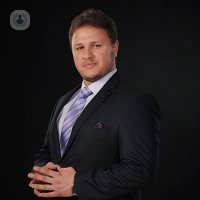Disappointed by varicose vein treatment? 3 common reasons why treatment fails
Escrito por:The appearance of varicose veins on the legs and feet can cause people to be self-conscious and may affect their confidence. The purple or blue colour and the distortion sometimes caused by the swelling and enlarging of these veins may lead patients to seek out treatment. Unfortunately, varicose veins may well reoccur if the treatment is of poor quality, resulting in disappointing outcomes for patients. In this article, award-winning consultant venous surgeon, Dr Omar Abu-Bakr, renowned for his use of innovative technology in treating varicose veins outlines three common causes of varicose vein recurrence after treatment and advises on what patients can expect from high quality treatment.

What causes varicose veins to reoccur after treatment?
First of all, it is important to acknowledge that varicose veins, if treated properly, only have a 3% risk of recurrence. Unfortunately, ineffective treatment leads to a far greater rate of recurrence, causing patients distress, further expense and disruption. Many factors can lead to varicose vein recurrence, but the most common are:
- using old fashioned techniques, now deemed unfit for purpose
- ineffective use of new technology which has the potential to achieve excellent results
- inaccurate scans taken before the procedure
How is old fashioned treatment for varicose veins ineffective in the long term?
Old fashioned techniques, such as stripping, have become outdated. Based on modern research and studies, the scar tissue that remains after treatment has been found to favour the formation of new veins to replace those removed during treatment. These new veins are called neovascular tissue and they contain no valves. In other words, varicose veins are dilated and the valves inside them do not work properly anymore, causing them to swell and darken in colour. The new veins that form after stripping treatment also do not contain valves, meaning that they are also varicose veins and will go on to develop the same appearance as those the surgeon initially treated. This explains why after stripping, the likelihood of varicose veins returning is more than 80%.
On the other hand, the healing process after newer techniques is different, giving vastly improved long-term results. Providing that the new procedures are performed correctly, the body heals by absorbing the treated veins instead of building new bad ones. The reason for that is that when using new treatment methods, such as endovenous laser ablation (EVLA), endovenous microwave ablation (EMWA) and high intensity focused ultrasound (HIFU), the end goal is to induce ‘unprogrammed natural cellular death’, also referred to as unprogrammed apoptosis. This means the body will not see the surgery as an attack that it needs to fight against by rebuilding new veins to replace the missing ones, unlike the more traditional stripping procedure.
When are newer treatments found to be ineffective in the long-term?
Another cause of varicose vein recurrence can be an incorrect use of new treatments. To induce the natural cellular death of the venous wall and successfully treat the varicose veins, we need to deliver the correct amount of energy according to the length and size of the veins. This amount of energy is must be correct and the delivery is called LEED (Linear Endovenous Energy Dissemination). Failing to do so accurately will result in certain failure of the treatment and recurrence of the varicose veins in the future.
How can inaccurate scans affect the quality of varicose vein treatment?
The very first step in treating varicose veins is to do a proper and thorough Doppler-Ultrasound scan, which takes at least 40 minutes to be performed correctly. The reason for that is that there are around one hundred and fifty anatomical variations of veins in each leg that can become varicose veins. These include the saphenous veins, all of the anatomical variations of perforator veins (the communicators between the deep and superficial veins) and ending with the pelvic veins.
If only a quick scan is performed, for example just lasting five or ten minutes, an inaccurate and undetailed map of the veins will be produced, meaning that treatment will not be effective. When treating varicose veins, we start with a very comprehensive Doppler-Ultrasound scan and based on that we tailor the best treatment option for each individual leg. While in theatre, we have the confirmation that the targeted veins have been successfully treated based on energy readings and ultrasound images taken during the procedure.
To achieve good quality and long-lasting results for the patient, a thorough understanding of how the latest technology in the field can be used effectively is essential. Treating varicose veins is a beautiful combination between science and art, and if correctly done, the results are simply amazing.
If you are seeking treatment for varicose veins, you can book a consultation with Dr Abu-Bakr by visiting his Top Doctors profile.


